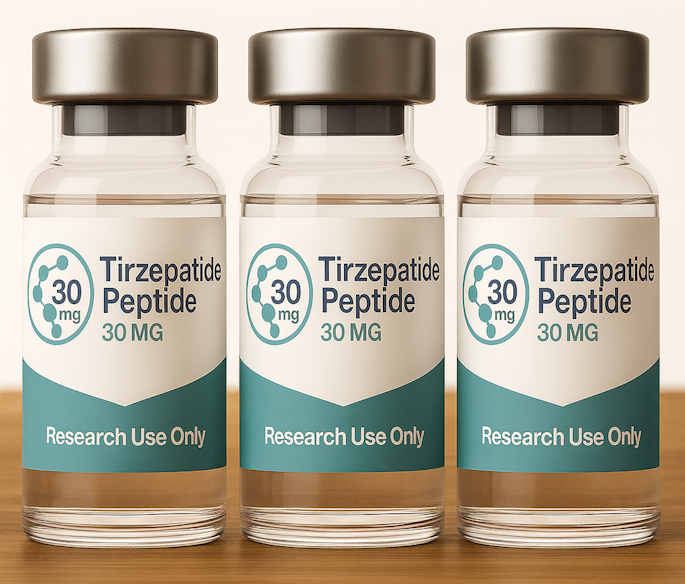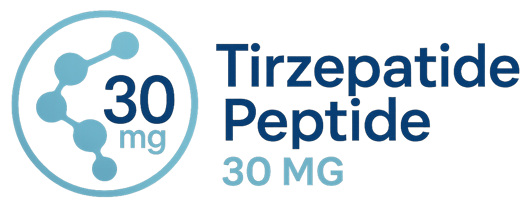Tirzepatide Peptide 30mg: 3 Trusted Sources & Research Overview

Tirzepatide peptide 30mg has become a notable subject in advanced laboratory research, offering insights into how dual-acting receptor agonist compounds may influence metabolic health markers. It is a lyophilized powder intended strictly for laboratory research use, meaning it is not for human consumption. Scientific studies focus on its potential role in body weight regulation, insulin response, and glucose metabolism.
🔍 Looking for verified research suppliers? Jump to the Trusted Sources for Tirzepatide Peptide 30mg section below.
While research into tirzepatide 30mg is still developing, studies often center on its unique profile as a dual agonist, targeting both GLP-1 and GIP receptors. As a GLP-1 receptor agonist, Tirzepatide demonstrates significant interest among researchers studying insulin release and metabolic regulation.
This combination has drawn interest for its possible weight management applications, particularly in the context of obesity-related research chemicals exploration. Researchers often classify tirzepatide 30mg as a weight management peptide, given its impact on satiety signaling and glucose control observed in preclinical studies.
It is important to emphasize that these substances are for qualified professionals operating in secure laboratory environments, addressing any concerns related to their use.
Laboratory Research Purpose
Within laboratory research, this GIP dual agonist compound is studied for its ability to interact with receptors linked to glucose and energy regulation, including the glucose dependent insulinotropic polypeptide. These studies do not involve human participants but instead examine molecular interactions and signaling pathways. A compounding pharmacy may provide materials for controlled research under proper licensing, ensuring the quantity supplied meets investigative needs.
The glucose dependent insulinotropic polypeptide pathway, combined with GLP 1 activity, has been a focal point in recent metabolic studies. Researchers verify all handling procedures and store the vial under specific conditions to maintain sample integrity.
Product Form and Handling
Tirzepatide 30mg is commonly supplied as a lyophilized powder in a sealed vial. This form is chosen for stability and extended shelf stock life. Before injection in an experimental setup, reconstitution is required. Learn more about lyophilized tirzepatide and its role in modern metabolic research.
For a detailed step-by-step process, see our full guide on how to reconstitute tirzepatide.
Researchers freeze unused material and protect it from light exposure to preserve quality. Once reconstituted, it is generally kept in a refrigerator for a defined period, following precise storage protocols.
Learn more about why tirzepatide needs to be refrigerated and how proper temperature control preserves potency.
The initial dose in studies may vary based on experimental design, and dosage adjustments are made as data is assessed. These parameters must be formulated in accordance with the research objectives and under the guidance of qualified professionals.
Mechanism of Action in Research
The interest in this peptide lies in its activity as a receptor agonist for both GLP 1 and GIP receptors. These receptors are involved in insulin release, satiety signaling, and body weight regulation. Studies involving this drug often look at how stimulating multiple receptors can lead to metabolic benefits beyond those of single-pathway agents.
In obesity-related research, compounds like tirzepatide 30mg are assessed for potential effects on caloric intake, food cravings, and weight management outcomes. The weekly administration model in research allows for consistent monitoring of physiological responses over weeks or months.
To understand how long the compound remains active after each study dose, see how long tirzepatide stays in your system.
Dosage and Administration in Research Settings
The dose of tirzepatide 30mg used in research is carefully defined in the study protocol. The vial contents are reconstituted with sterile solution, drawn into a syringe, and administered at controlled injection sites. These injections are purely for laboratory research use, not for human subjects.
A weekly schedule is often employed to track longitudinal changes. The quantity used per session is based on experiment-specific dosage plans.
For conversion charts and weekly escalation examples, read our tirzepatide dosage in units guide.
In some reviews of prior studies, experimental models receiving this compound showed improvements in glucose tolerance and body weight control, although no cure claims are made.
Storage and Stability
For tirzepatide 30mg, proper storage is critical. The lyophilized powder should remain in its vial, stored in a refrigerator or freeze conditions, shielded from light. The stock must be maintained in a controlled laboratory environment with limited access.
Once reconstituted, the solution’s stability may last days to weeks, depending on handling. Research protocols monitor solution clarity and composition to ensure the sample remains viable for testing.
Safety and Handling Notes
All work with tirzepatide 30mg must be performed by qualified professionals trained in handling research chemicals. Safety procedures require protective equipment, designated workspaces, and proper disposal methods for unused chemicals. Researchers consult safety data sheets, note storage guidelines, and follow relevant regulatory standards, including those recognized by organizations like the FDA for investigational handling.
Since this compound is intended for non-clinical purposes, there are no approved human dosing instructions, and any concerns regarding handling must be addressed through internal lab protocols.
Research Context and Industry Background
This compound was originally developed by Eli Lilly, and is widely known in clinical contexts for type 2 diabetes treatment and potential weight management benefits. However, the tirzepatide 30mg variant discussed here is specifically packaged and sold for laboratory research use only.
In the research supply market, 30mg quantity options may be listed on a website page detailing specifications, available stock, and pricing. A link to relevant review data may be included for academic purposes. Bulk quantity orders are sometimes available, though costs vary, and researchers must allocate money for high-purity compounds.
Weekly Study Models
In many experiments, this peptide is administered on a weekly basis over several weeks. This schedule allows researchers to measure progressive responses and track biomarker changes. Injection sites are rotated in models to prevent local tissue interference.
The vial format, combined with lyophilized powder stability, allows for long-term projects where a defined dose is delivered at precise intervals. Such weekly protocols help create consistent datasets for academic review and monitor potential long-term effects of the drug.
Trusted Sources for Tirzepatide Peptide 30mg
When sourcing Tirzepatide Peptide 30mg for laboratory use, it’s essential to verify purity, supplier transparency, and testing documentation. Below are several trusted sources that provide verified, research-grade Tirzepatide in lyophilized form.
1. Core Peptides
Product Specifications:
- Size: 10mg per vial
- Price: $203.30 per vial
- Discounts: 5–8 vials receive a 5% discount; 9+ vials receive a 10% discount
- Purity: >99%
- Form: Lyophilized powder
Core Peptides offers high-purity Tirzepatide verified through independent laboratory testing. Each vial is accompanied by a Certificate of Analysis and is designed exclusively for laboratory research use. Products are shipped with temperature protection and should be stored in a cool, light-controlled environment.
2. Limitless Life Nootropics
Product Specifications:
- Size: 5mg and 10mg vials available
- Purity: >98%
- Form: Lyophilized powder
- Testing: HPLC and Mass Spectrometry verified
Limitless Life Nootropics supplies a wide range of research peptides, including Tirzepatide, sourced from GMP-certified manufacturers. The company provides downloadable testing results for each batch and follows strict handling standards. Their Tirzepatide peptide is intended for in-vitro and in-vivo laboratory research applications only.
3. Ameano Peptides
Product Specifications:
- Size: 10 mg per vial
- Purity: ≥ 99 %
- Form: Lyophilized powder
- Testing: HPLC / MS certificates available
- Packaging: Temperature-protected shipping
Ameano Peptides provides Tirzepatide as a high-purity research peptide accompanied by complete analytical documentation. Each vial is sealed for long-term stability and stored under controlled conditions prior to shipment. Products are clearly labeled for laboratory research use only.
Comparison Table: Tirzepatide Peptide Suppliers
| Supplier | Size (mg / vial) | Price / Discount Info | Form / Notes / Testing |
|---|---|---|---|
| Core Peptides | 10 mg | – $203.30 /vial – 5–8 vials (5% off / vial) – 9+ vials (10% off / vial) | Lyophilized powder, COA & independent testing |
| Limitless Life Nootropics | 5 mg 10 mg | Discounting or bundle pricing not publicly detailed | Lyophilized powder, USA-manufactured, claims GMP / third-party testing |
| Ameano Peptides | 10 mg, 15 mg, 20 mg, 30 mg, 60 mg | – 1-4 vials: $74 /vial – 5–9 vials (5% off / vial) – 10+ vials (10% off / vial) | Lyophilized powder, HPLC / MS certificates available |
Frequently Asked Questions
Q: Can I take 30 mg of tirzepatide?
No, Tirzepatide 30mg in research supply form is intended solely for laboratory research use and is not for human consumption. The initial dose and dosage used in clinical medicine are determined by qualified professionals under strict medical supervision, often far lower than 30 mg. Any handling of the lyophilized powder form should be done in a controlled laboratory environment by trained researchers, not administered for personal use.
Q: Does this peptide work for weight loss?
In laboratory research and published clinical studies, this coupound has been associated with significant reductions in body weight and measurable metabolic benefits. However, the tirzepatide peptide 30mg form sold as a research chemical is intended only for experimental studies and is not an approved drug for personal weight management for diabetes without regulatory clearance. In research contexts, outcomes may vary, and it is not marketed as a cure for obesity.
Q: What is tirzepatide 30mg mL?
The term generally refers to a prepared research solution after reconstitution of a lyophilized powder vial containing 30mg quantity of tirzepatide. The final mL volume depends on the solvent used during reconstitution, which is defined by the experimental protocol. Researchers calculate the desired concentration based on the total dose per injection and the quantity of solvent added.
Q: How much does this peptide cost?
The cost of tirzepatide 30mg as a research chemical can vary based on purity, supplier, and stock availability. Some compounding pharmacy suppliers list pricing on their website page, but figures often range from several hundred to over a thousand dollars for a single vial. Qualified professionals typically review supplier credentials, verify testing standards, and factor in money for proper storage (such as freeze or refrigerator requirements) when budgeting for laboratory projects.
Q: How long does tirzepatide stay stable after mixing?
When stored at 36°F–46°F, most compounded tirzepatide solutions remain stable for up to 28 days before requiring disposal.
Q: Can tirzepatide be stored at room temperature?
Only temporarily. Exposure above 86°F can degrade the peptide chain and reduce potency. Refrigeration is always recommended.
Q: Is lyophilized tirzepatide the same as the injectable form?
No. Lyophilized tirzepatide is a research-grade freeze-dried powder, while injectables like Mounjaro are formulated and dosed for human clinical use.
Conclusion
This compound represents a significant focus in advanced metabolic research, particularly for its dual agonist profile targeting GLP 1 and GIP receptors. As a metabolic research compound, it is used exclusively in laboratory settings to explore mechanisms of insulin sensitivity and energy balance.
While often discussed for its potential role in diabetes and weight management, the tirzepatide peptide 30mg form is exclusively for laboratory research use, with no approval for clinical or human application.
When handled by qualified professionals in a laboratory environment, stored properly, and formulated according to strict protocols, tirzepatide 30mg can be a valuable asset in expanding the understanding of receptors, metabolic regulation, and future therapeutic possibilities. All handling should be done with the utmost care, under defined safety procedures, and in compliance with regulatory oversight. Researchers are advised to continue their studies cautiously, recognizing that findings may one day contribute to broader scientific knowledge.
Discover the Benefits of Tirzepatide Peptide
Explore detailed insights on Tirzepatide Peptide 30MG, its uses, advantages, and essential information for informed decisions.
Enhanced Blood Sugar Control
Supports effective regulation of blood glucose levels, promoting better health outcomes for those managing diabetes.
Weight Management Support
Aids in appetite suppression and weight reduction, contributing to improved metabolic health and well-being.
Improved Cardiovascular Health
May help reduce cardiovascular risks by positively influencing key health markers and overall heart function.
